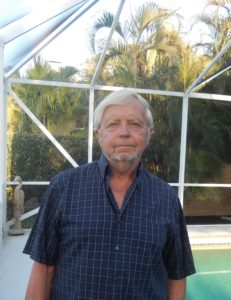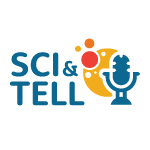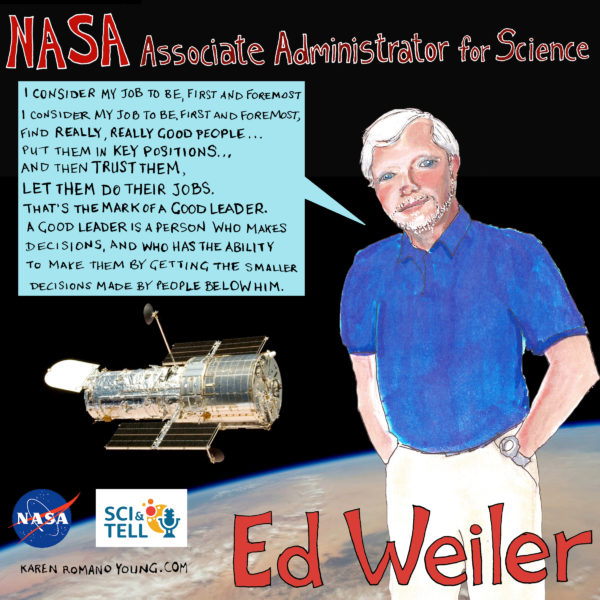Ed Weiler: From Hubble Trouble to Mars Success
05 July 2021

Ed Weiler only answered to one person when he was the Associate Administrator for Science at NASA Headquarters- the President of the United States. And after a decades long career in astronomy, working on everything from the Hubble telescope to the Mars program, he’s now spending his retirement playing tennis and raising a puppy. We talked to Ed about building a telescope at age 13, finding life outside of Earth in the near future, and leading a team of scientists at NASA- and that’s just the tip of the iceberg!
This episode was produced by Shane M Hanlon and Nisha Mital, and mixed by Collin Warren. Artwork by Karen Romano Young.
Transcript
Shane M Hanlon: When I first got my job at AGU, it was a big deal because I had made a pretty major switch from being a researcher to teaching science communication. But I figured I was in good hands. A few days into the job, I’m pulled into a meeting w/ my boss and her boss and told, Shane, you’re going to need to do Fall Meeting on your own. Turns out my boss wouldn’t be able to attend the meeting…the meeting that is the biggest thing we do every year. The meeting where >25k people descend on some city to talk science for a week. Turns out the good hands I was in were pushing me into the fire. I was not stoked but, there was nothing I could do, so I took on the challenge. The meeting rolled around a few months later and…it was fine. I had a great support system, I learn pretty quickly, and (most) everything went off without a hitch. A I was lucky b/c I know that things don’t always turn out this way…
Shane M. Hanlon: Everyone has a story, even, or maybe, especially, scientists. Science affects each and every one of us. Let's talk about it. From the American Geophysical Union, I'm Shane Hanlon, and this is Sci & Tell.
Shane M Hanlon: Today’s going to be a little different. If you’re been listening along to our first few episodes you recognize my voice (and if you haven’t, I highly suggest you go back). But I want to introduce my, now co-producer Nisha Mital, who’s going to working w/ me on upcoming episodes. Hi Nisha.
Nisha Mital: Hi Shane.
Shane M Hanlon: OK, can you give us a little preview of our next interview?
Nisha Mital: Sure - Today we’re back to NASA where we chatted with Ed Weiler. Ed’s now retired but he has some wild stories from his time as NASA and y’all are in for a treat.
Shane M Hanlon: Our interviewer was Paul Molin.
Dr. Edward J. Weiler: I'm Dr. Ed, Edward J. Weiler, I go by Ed. I finished my career at NASA Headquarters as Associate Administrator for Science. That's the person who basically runs a science program at NASA. I had done that for nine years, from about 1998 to 2004 but then got sent to Goddard Space Flight Center to be Center Director for about four years. After they went through four AAs for science in four years, they called me back to headquarters in 2008, where I was, again, the Associate Administrator for Science for three years and I retired from NASA in 2011.
Dr. Edward J. Weiler: Basically, all of science, earth science, solar physics, astronomy, planetary science was my domain. All missions that did science in space for those fields were my responsibility. Grant research on the ground was my responsibility in those areas. Building the missions and flying the missions, basically birth to death, so to speak.
Dr. Edward J. Weiler: I spent a lot of time trying to make science understandable to normal people, especially kids. I instill a regular press conference series on science called Space Science Updates back before Hubble was even launched, where we brought many ... two or three scientist in to talk about science results, but not just scientists, because a lot of scientists can't speak to the public, period. I brought in scientists that really were good communicators.
Dr. Edward J. Weiler: I consider my job to be first and foremost. Find really, really, really good people, put them in key positions and then trust them. Let them do their jobs.
That's the mark of a good leader. A good leader is a person who makes decisions and a good leader is a person who basically has the ability to make good decisions by getting the smaller decisions made by people below him.
Dr. Edward J. Weiler: When I was about nine or 10, I grew up in Inner-city Chicago, blue collar, not a lot of money. My father and mother bought me a little paperback book that probably cost 50 cents called Stars, S-T-A-R-S. Just stars. It's a little book written for kids like eight or nine or 10 years old, that talk about stars and planets and galaxies
So I read this book and I really got kind of interested.
So I sent away, I made $3 washing the floor or something. Sent away for a three dollar telescope made out of cardboard, big long cardboard tube with a little lens at one end and a little lens at the other end. It was enough to see Venus as a crescent. It was enough to see a few craters on the moon. It was enough to see Jupiter's moons. It wasn't great, but it was something I'd never seen before. I got really kind of excited and about a year later, my dad bought me a real telescope, a little Japanese 2.4 inch refracting telescope and that really turned me on, continued to get interested and then, the thing that really got me hooked was there was going to be a lecture on astronomy at Northwestern University in Evanston, Illinois, north of Chicago.
The chairman of the department, J. Allen Hynek was going to be giving his lecture. He is ... so some note, he wrote the book, "Encounters of the Third Kind." Do you ever saw the movie?
Dr. Edward J. Weiler: [H]e gave a lecture on astronomy and something else that later in my life turned out to be really, really critical. The search for life in the universe. He was a believer back in the 60s, that there had to be other intelligent life in the universe and for that, most astronomers didn't respect them. They thought he was a crackpot but he was prescient. I mean, this is a time remember when there was no proof that there was even another planet other than the nine in our solar system? Not one, not thousands but not one. This guy was inspiring to me, to the point ... at age 13, I built a six inch reflecting telescope. I went to the Adler Planetarium, learned how to grind a mirror. I built my own 100 pound telescope, six inches in diameter, about four feet long.
I made a decision, I wanted to become an astronomer. I wanted to go to Northwestern University and I wanted to work for NASA someday. At age 13, those are my goals and I accomplished all three.
Dr. Edward J. Weiler: [B]ack in 1976, when I was going to be looking for a job, the job market in astronomy was not great. I mean, normally in astronomy or in physics, you go from your PhD into a university, you become a professor. That's the normal job path. Okay. There are no jobs right now. It was very, very, very hard to find a job anywhere. So I had applied to ... I looked for a backup because I had to eat, right, because I wasn't rich. I was living off scholarships. So I got an offer, job offer to become a computer programmer.
I was asked to become a computer program for American Hospital supply up in the North of Chicago and I was on the verge of accepting that job, when my thesis advisor, Dr. John Bond, who was good friends with a professor at Princeton University and Princeton University at the time, was operating under contract, a satellite, a precursor for Hubble called Copernicus, a one meter telescope under a guy named Lyman Spitzer. They had a bunch of astronomers based at Goddard Space Flight Center, working on this satellite, keeping it operating and doing research with it.
One of them had left and they had a job opening for a young astronomer, to come to work for Princeton, doing research and also working on the Copernicus satellite. So, John got me an interview. I flew out to New Jersey, to Newark, went down for the interview, did the interview, came back to Evanston. A couple days later, I was offered a job and I suddenly went from computer programmer in an American Hospital supply to a staff researcher at Princeton University. I mean, when I think of how things could have gone, how lives could have gone and just again, pure coincidence. Remember, I said I worked on Hubble as the chief scientist for 30 years.
Lyman Spitzer is known today ... he's now dead but he's known today as the father of the Hubble Space Telescope. He's the one that pushed it since the 1950s and sold it to Congress and got it launched. He was my first boss at Princeton.
Dr. Edward J. Weiler: So, I'm at Goddard but I'm a Princeton astronomer at Goddard under contract. I spent about a week, a month at Princeton, doing some research and then, three weeks a month at the Goddard Space Flight Center, helping to schedule and operate the Copernicus satellite orbiting ... it was called Orbiting Astronomical Observatory 3, OAO-3. I spent about three years there, three and a half years and one day, Nancy Roman, Dr. Nancy Roman, who was the chief of astronomy and the chief scientist for Hubble. It was just being developed in, from NASA headquarters said she wanted to see me.
I said, "My God." I was just a lowly Princeton astronomer and here the chief of astronomy at NASA is coming down to Goddard to see me in my little tiny office that I share with three people. So she shows up and says, she's got an opening for her assistant, staff astronomer at NASA headquarters in the astronomy branch. I'll help broaden Hubble and the rest of the things that the astronomy branch did. At that time ... it was funny, because having worked for Lyman Spitzer, who's probably one of the greatest American astronomers in history, I had a different perspective on my own career. Here, Nancy Roman was offering me an opportunity to work for the government as a scientist, to help other people do science.
To help launch satellites, to manage science. Basically, to enable other people to do science. I had to make a decision, was my impact on science going to be more my doing science at Princeton or being at headquarters, helping to sell science to Congress and OMB and et cetera, et cetera. I kind of made a decision, I realized that I could never be a Lyman Spitzer. I mean, I was a decent scientist but I could never be a Lyman Spitzer, doing my own research. I could probably do lots of papers a year and have a nice career teaching and all that kind of stuff. What impact would I have and I decided to take the job at NASA.
It was a major commitment because I was going to be giving up research. For three years, I was publishing papers and getting my name and the press for whatever what that's worth, ultimately. So I made a decision to come to NASA in 1978, under Nancy Roman, who was the chief scientist on Hubble around the astronomy branch. Of course, coincident hits again, she decides to retire a year later and I become the chief scientist of Hubble in 1979 and the chief of astronomy, and the rest is history.
Dr. Edward J. Weiler: [W]hat defined me clearly which prepared me totally for the Mars failure because what I went through on Hubble made me realized that you got to always be a worst case planner. It may sound pessimistic but if you plan for the worst case, if it happens, you're ready for it. If it doesn't happen, you're happy.
Dr. Edward J. Weiler: When we launched Hubble, there was a technical mistake made at PerkinElmer Corporation and the mirror had the wrong curve at the level of a millionth of an inch. It was a perfectly smooth curve. It was the finest smoothest mirror ever made by humans but it was perfectly wrong. So that when we turned on Hubble, everything was out of focus and the press just had a field day. Hubble trouble was the word on every ... don't ever name a satellite that rhymes with trouble.
So back in 1990, in June, when we discovered we had this optical problem, that was going for ... when we launched Hubble… Because the mirror was perfect, perfect curve and we were able to measure how much error there was in it, it was like fixing your eye. I'm nearsighted. I should be wearing glasses right now. My eyes are perfect. They're nice curve but my eyes have the wrong curve, which means light doesn't focus at the same point.
What do I have to do to fix that? I put on a pair of glasses with the opposite curve of that curve and it cancels out the problems, and I can see clearly. Therein lies the key to the Hubble solution. So we discovered back in the late 90s, that we could fix this problem, because we had a backup camera being made. The backup camera had eight little mirrors in it, okay, and these mirrors were the size of a nickel. Cameras or if you ever open up, not an iPhone camera but a real camera like a Nikon, it's full of lenses and mirrors and everything. Well, the inside ... the camera on Hubble was the size of a telephone booth.
It's got optics all over the place. Well, just at the right place, there were four mirrors that were flat, just flat mirrors that just reflected light. We figured out that if we put a little curve on each one of those four mirrors, that was the opposite of the mistaken curve on the Hubble, we could correct the problem inside the new camera. That is take out the old camera, put in a new camera with these little curved mirrors and everything would be hunky dory. Because there was a backup camera being built, we were able to have it ready for the first shuttle mission to Hubble in 1993
Jump to the end of the story, nobody believes we're going to fix it. We're going to ask the shuttle astronauts to do five EVAs, eight hours long. Never been done before. Not only did we have trouble with the mirror but the solar panels were screwed up. They're European solar panels that were waving in the sunlight. I won't go into all the problems, but there are a lot of problems.
So we went up there, the astronauts pulled off every EVA. I remember being in Johnson Space Flight Center in the middle of night watching these EVAs, thinking I was in a dreamland because everything went perfectly, perfectly. We finished all the work, got the new camera in, got the solar panel, all the fixes. Of course, it was like doing eye surgery and when the astronauts left, the bandage were still on because we hadn't tested the new camera. So on December 20th, 1993, the mission ended December 2nd or 3rd 1993, the shuttle mission. On December 20th, we're taking the bandages off the new camera so to speak. We're going to put light down the camera for the first time.
[S]o there I am up at the Space Telescope Science Institute on the Johns Hopkins campus in Baltimore. That's where all the data comes down, that's where the science is done. Okay, it's operated from Goddard Space Flight Center but the science is done up at the Space Science Telescope Institute. So, we're all huddled around a computer screen. Okay? The first picture comes in from the new camera. In the old days, again, before we ... the stuff we have today, picture is built up slowly on analog televisions, right? It started showing. Suddenly, we saw that instead of a big blurry dot, a bunch of dots, one very bright star was in the center and hundreds of other very bright stars, smaller stars were spread around, all in perfect focus.
It was total silence and suddenly, on camera because they were filming this, I uttered, "Holy shit."
Nisha Mital: So Shane, have you ever had a moment like that where something just came into clarity or you had that “aha” moment?
Shane M Hanlon: Yano, I’m sure I have but I don’t know that it’ll top Ed’s experience so I want to thank him for sharing his stories with us.
Shane M Hanlon: Special thanks to NASA for making this episode possible, to Nisha for producing, and to Paul Molin for conducting the interview.
If you like what you've heard, stay tuned for future episodes. You can subscribe to Sci & Tell wherever you get your podcasts and find us a sciandtell, all spelled out, .org.
From these scientists in our respective home studio, to all of you out there in the world, thanks for listening to our stories.

